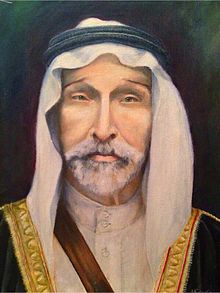
The Bedouin, Beduin, or Bedu are pastorally nomadic Arab tribes who have historically inhabited the desert regions in the Arabian Peninsula, North Africa, the Levant, and Mesopotamia (Iraq). The Bedouin originated in the Syrian Desert and Arabian Desert but spread across the rest of the Arab world in West Asia and North Africa after the spread of Islam. The English word bedouin comes from the Arabic badawī, which means "desert-dweller", and is traditionally contrasted with ḥāḍir, the term for sedentary people. Bedouin territory stretches from the vast deserts of North Africa to the rocky ones of the Middle East. They are sometimes traditionally divided into tribes, or clans, and historically share a common culture of herding camels, sheep and goats. The vast majority of Bedouins adhere to Islam, although there are some fewer numbers of Christian Bedouins present in the Fertile Crescent.

The tribe of Shammar is a tribal Arab Qahtanite confederation, descended from the Tayy, which migrated into the northern Arabian Peninsula from Yemen in the second century. It is the largest branch of the Tayy, and one of the largest and most influential Arab tribes. The historical and traditional seat of the tribe's leadership is in the city of Ḥaʼil in what was the Emirate of Jabal Shammar in what is now Saudi Arabia. In its "golden age", around 1850, the Shammar ruled much of central and northern Arabia from Riyadh to the frontiers of Syria and the vast area of Upper Mesopotamia.
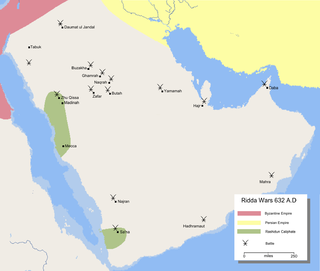
The Ridda Wars were a series of military campaigns launched by the first caliph Abu Bakr against rebellious Arabian tribes. They began shortly after the death of the Islamic prophet Muhammad in 632 and concluded the next year, with all battles won by the Rashidun Caliphate.

The Tayy, also known as Ṭayyi, Tayyaye, or Taiyaye, are a large and ancient Arab tribe, among whose descendants today are the tribes of Bani Sakher and Shammar. The nisba (patronymic) of Tayy is aṭ-Ṭāʾī (ٱلطَّائِي). In the second century CE, they migrated to the northern Arabian ranges of the Shammar and Salma Mountains, which then collectively became known as the Jabal Tayy, and later Jabal Shammar. The latter continues to be the traditional homeland of the tribe until the present day. They later established relations with the Sasanian and Byzantine empires.

Bani Khalid is an Arab tribal confederation mainly inhabiting the Arabian Peninsula. The tribe ruled southern Iraq, Kuwait, and Eastern Arabia from the 15th century to the 18th century, and again under the auspices of the Ottoman Empire during the early 19th century. At its greatest extent, the domain of Bani Khalid extended from Iraq in the north to the borders of Oman in the South, and Bani Khalid wielded political influence by ruling the region of Najd in central Arabia. Most of the tribe's members presently reside in eastern and central Saudi Arabia, while others live in Iraq, Kuwait, Qatar, Bahrain, Syria, Palestine, Lebanon and the United Arab Emirates. Bani Khalid has both Shia Muslim and Sunni Muslim members.
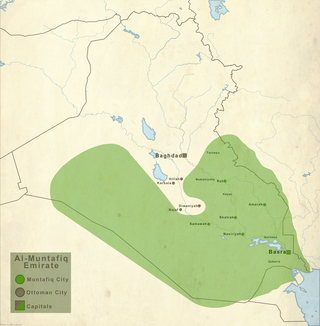
Al-Muntafiq was a large Arab tribal confederation of southern Iraq and Kuwait. The confederation's tribes predominantly settled in Iraq's southern provinces and northern Kuwait. The confederation is not homogeneous in terms of sect/religion. Centuries of intermarriage and intermingling created a mix of Sunni and Shia tribes. Therefore, a minority of individual tribes within the confederation is Sunni. Overall, it is almost impossible to delineate who is, and who is not part of the Muntafiq.
Al-Dhafeer is an ancient Arabian tribe, that goes back to Tayy. It used to control the entirety of the Najd region of the Arabian Peninsula from around 1300 to 1590 AD. They were known as warriors of the Arabian region 700 years ago, united and always together despite their huge numbers. Starting in the 1300s, Al-Dhafeer resided around Medina, close to Mecca. Now most of the tribe lives in Kingdom of Saudi Arabia taking positions such as professors, politicians, scholars, doctors and engineers. They also live in Kuwait, United Arab Emirates, Bahrain, Iraq, Jordan, and Qatar.

The Bani Hamida are a nomadic Bedouin tribe living in Jordan.
The Ghamd is an Azd Arab tribe of the Hejaz Region. They are predominantly Sunni, and are considered one of the oldest tribes of the Arabian Peninsula. The Ghamid people are thought to be closely related to the neighboring tribe of Zahran.
The Adwan Rebellion or the Balqa Revolt was the largest uprising against the newly established Transjordanian government, headed by Mezhar Ruslan, during its first years.
The Tiyaha or Tiyahah is a Negev Bedouin tribe. Their traditions state that they originated from near Medina and settled in the Sinai Peninsula during the early years of the Muslim conquests. They were led by one named Rabab and the five main sub-groups trace their roots to his five sons.
The 1757 Hajj caravan raid was the plunder and massacre of the Hajj caravan of 1757 on its return to Damascus from Mecca by Bedouin tribesmen. The caravan was under the protection of an Ottoman force led by the Wali of Damascus, Husayn Pasha, and his deputy Musa Pasha, while the Bedouin were led by Qa'dan al-Fayez of the Bani Sakher tribe. An estimated 20,000 pilgrims were either killed or died of hunger or thirst as a result of the raid.
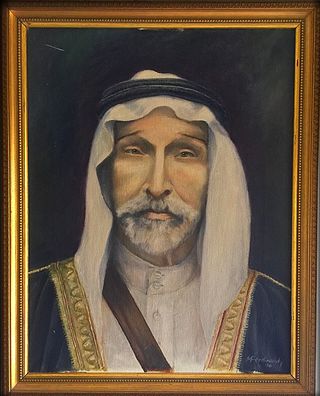
Haditha Ali Abdullah Al-Khraisha was a Jordanian Bedouin tribal leader. He was one of the two paramount sheikhs of the Bani Sakhr Tribe, arguably the most powerful tribe in Jordan. Haditha headed the northern clans of the Bani Sakher (al-Ka'abnah), while Mithgal Al-Fayez headed the other half, (al-Twaga). In the early twentieth century, Haditha and the Bani Sakhr, in addition to other Trans-Jordanian tribes such as the Huweitat and the Belqawiah, fought the Wahhabi Ikhwan, a religious militia who helped establish Abdul Aziz Ibn Saud as the first King of Saudi Arabia. The Wahhabi Ikhwan were Abdul Aziz Ibn Saud's tool for territorial expansion and lent religious legitimacy to Ibn Saud's territorial and political ambitions. According to King Faisal Al Saud the armed resistance that Bani Sakhr put up against Ibn Saud and the Wahhabi Ikhwan was "the reason that Saudi Arabia's borders do not extend all the way to Palestine and why the Al Sauds never became the rulers of the Levant". Haditha was known throughout Arabia for his wisdom and chivalry, He played a significant role in building the nascent Jordanian state and shaping its development. An ally and supporter of King Abdullah I, Haditha served several terms as Senator and Parliamentarian, including the first Jordanian Senate in 1947 which consisted of only ten members. Haditha was also elected to the second Legislative Council in June 1931, and the Fourth Legislative Council in 1937 while Jordan was still an Emirate. Haditha was also one of the founding members of the Jordanian Solidarity Party in March 1933. Sheikh Haditha also cultivated the oasis of Azraq, Jordan.

Mithqal bin Sattam bin Fendi Al-Fayez (Arabic: مثقال الفايز, was a Jordanian political and tribal figure whose work helped the establishment of The Hashemite Kingdom of Jordan. Mithqal was one of the two leading sheikhs of Bani Sakhr; he took power in the early twentieth century, and headed the Bani Sakhr tribe generally and the Al-Twaga half of the tribe specifically, which consisted of the four major clans, Al Ghbeyen, Al Ghuful, Al A'lqam, and Al Tabab, which comprise of 32 sub-clans which further divide into more sub-clans. He also headed his own clan, Al-Fayez.
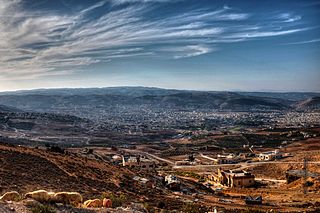
The Balqa, known colloquially as the Balga, is a geographic region in central Jordan generally defined as the highlands east of the Jordan Valley in between the Zarqa River to the north and the Wadi Mujib gorge to the south.
The House of Fayez(Arabic: الفايز or, colloquially: Al-Fayez, Alfayez, Al Fayez, Al Faiz, Al Fayiz) is a noble sheikhly Jordanian family that heads the major Jordanian clan Bani Sakher. The family's influence and prominence in the region was at its ultimate under Fendi Al-Fayez, who led the family in the 1840s and gradually became the leader of the entire Bani Sakher. Fendi would rule large parts of Jordan and Palestine, including the ancient Kingdoms of Moab and Ammon, and parts of modern-day Saudi Arabia until the late 1860s when a series of battles with the Ottoman Empire decreased the family's resources and claimed a portion of its holdings. After Fendi, his young son Sattam led the tribe in a push to cultivate the lands and live a more sedentary lifestyle, then under Mithqal Alfayez as a permanent political power in modern Jordan. The family was the largest owner of land in Jordan and owned portions of modern day Palestine, and Mithqal was the single largest owner of private land in the kingdom in 1922. The Al-Fayez family is active in Jordanian and Arabian politics and is currently headed by former Prime Minister Faisal Al-Fayez.

Fendi bin Abbas bin Awad Al Fayez was an Arab leader and a sovereign Emir from the Al-Fayez family who was the paramount Sheikh of the Bani Sakher Clan from the 1820s up until his death. He is widely regarded as the most influential figure in the Bani Sakher, dubbed the Old King east of the Jordan and one of the most powerful tribal figures in Arabia in the 19th century. Fendi's first documented tribal battle was as early as 1820 when he was just twenty years old.

Sattam bin Fendi bin Abbas Al Fayez (Arabic: سطام الفايز, was an emir who led the Bani Sakher tribe from 1881 until his death in 1891. He was the de facto ruler of the Bani Sakher after his father Fendi Al-Fayez gave him most of his responsibilities in the late 1870s, and was the first person to have led Westerners to view the Moabite Stone in 1868. Sattam was also the first tribal sheikh to begin cultivating land in the 1860s, which began the sedentary settlement process of many of the biggest tribes in Jordan. In September 1881, after the reunification of the Al-Fayez family under Sattam, he was recognized by the Ottoman Administration as the Emir of Al-Jizah and the paramount Shaykh of the Bani Sakher clan.
Sheikha Al Anoud bint Dahham Al Fayez is a Jordanian noblewoman and former Saudi royal. She is the daughter of one of the sheikhs of the Al-Fayez clan from Bani Sakher, Sheikh Daham bin Dardah Al-Bakhit Al-Fayez and his wife Gutnah bint Mithqal Pasha Al-Fayez, daughter of the paramount Sheikh of the Bani Sakher. She was the wife of King Abdullah bin Abdulaziz Al Saud from 1972 to 2003 following a divorce. She is the mother of four daughters: Jawaher, Hala, Maha, and Sahar Al-Saud.
Sami Mithqal Al-Fayez was a Jordanian senator and Arabian tribal figure who was the paramount sheikh the Bani Sakher.


